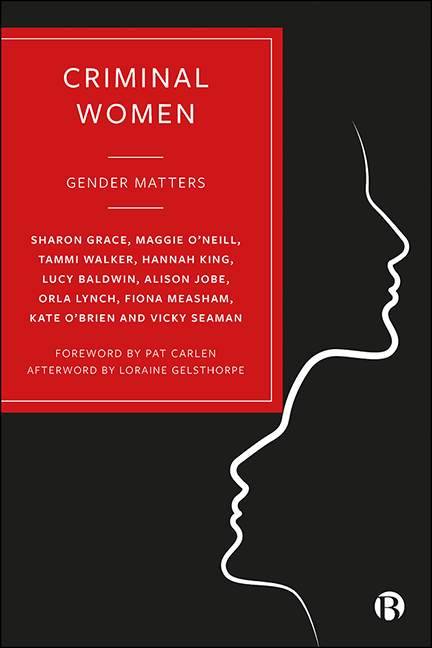Book contents
- Frontmatter
- Contents
- List of Figures and Table
- Notes on the Authors
- Acknowledgements
- Foreword
- Introduction
- 1 Hearing the Voices of Women Involved in Drugs and Crime
- 2 Knifing Off? The Inadequacies of Desistance Frameworks for Women in the Criminal Justice System in Ireland
- 3 Sex Work, Criminalisation and Stigma: Towards a Feminist Criminological Imagination
- 4 Criminal Women in Prison Who Self-harm: What Can We Learn from Their Experiences?
- 5 Criminal Mothers: The Persisting Pains of Maternal Imprisonment
- 6 ‘The World Split Open’: Writing, Teaching and Learning with Women in Prison
- 7 Women’s Biographies through Prison
- Afterword
- Index
4 - Criminal Women in Prison Who Self-harm: What Can We Learn from Their Experiences?
Published online by Cambridge University Press: 15 September 2022
- Frontmatter
- Contents
- List of Figures and Table
- Notes on the Authors
- Acknowledgements
- Foreword
- Introduction
- 1 Hearing the Voices of Women Involved in Drugs and Crime
- 2 Knifing Off? The Inadequacies of Desistance Frameworks for Women in the Criminal Justice System in Ireland
- 3 Sex Work, Criminalisation and Stigma: Towards a Feminist Criminological Imagination
- 4 Criminal Women in Prison Who Self-harm: What Can We Learn from Their Experiences?
- 5 Criminal Mothers: The Persisting Pains of Maternal Imprisonment
- 6 ‘The World Split Open’: Writing, Teaching and Learning with Women in Prison
- 7 Women’s Biographies through Prison
- Afterword
- Index
Summary
In England and Wales, women in prison make up a minority of the total custodial population yet acts of self-harm are around five times more common among incarcerated women. Policymakers have introduced suicide prevention programmes in prisons (HM Prison Service, 2001) and, while there has been a multiagency effort to improve how acts of self-harm are documented across prisons, the accounts of why women in prison self-harm is yet to be fully addressed. This chapter will explore the motivations associated with self-harm for imprisoned women and what we can learn from their experiences. Drawing on the voices of women, the chapter will provide insight into the intra-personal and/or inter-personal motivations for self-harming in prison. The chapter will finish with a reflection of what has stayed the same and what has changed since Carlen et al's (1985) original book in relation to self-harm.
Background
Self-harm is a challenge for the criminal justice system (CJS) due to its associations with physical injury, psychology co-morbidity and increased lifetime suicide risk (Hawton et al, 2013). The conceptualisation and definition of what has been characterised as ‘self-harm’ remains problematic. A number of different terms and definitions are used in research, policy and practice spheres. Terms such as ‘attempted suicide’, ‘self-injury’, ‘deliberate self-injury’, ‘self-mutilation’, ‘suicidal gesture’, ‘abortive suicide’, ‘self-inflicted violence’ and ‘para-suicide’ are used interchangeably. Walker and Towl (2016) note how issues of confusion continue to remain by the use of multiple definitions. It is clear, though, that individuals may self-harm either with or without any intention to kill themselves. The differing terminology used in literature can lead to difficulties in making comparisons across studies (Walker and Towl, 2016).
Her Majesty's Prison and Probation Service (HMPPS) (as stated in PSI 64/2011) defines self-harm as ‘any act where a prisoner deliberately harms themselves irrespective of the method, intent or severity of any injury’ (HM Prison Service, 2001). This can include self-harm by cutting, scratching, head-banging, punching a wall, self-poisoning, fire setting, suffocation, swallowing and/or insertion of objects and wound aggravation.
- Type
- Chapter
- Information
- Criminal WomenGender Matters, pp. 87 - 106Publisher: Bristol University PressPrint publication year: 2022



